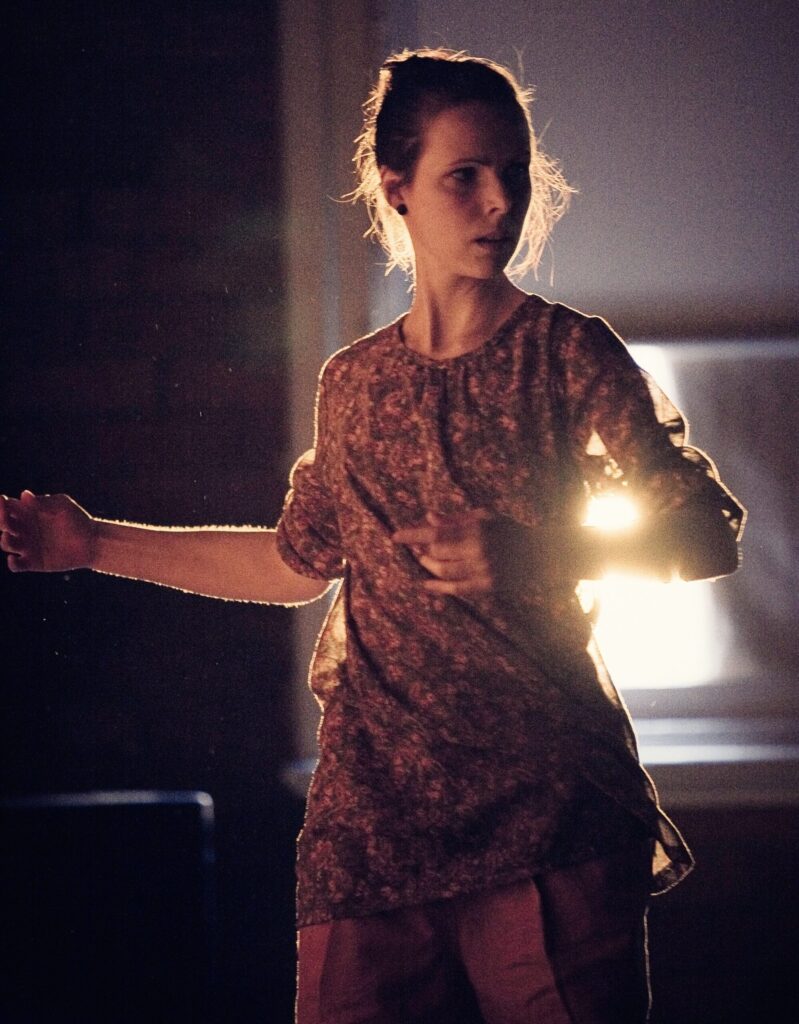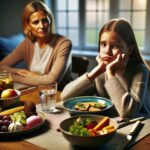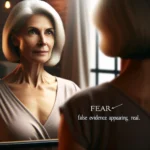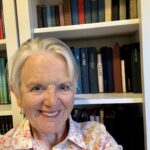My journey as a performing artist with anorexia nervosa

My journey as a performing artist with anorexia nervosa
Using the stage to face fear head-on
When most unwell with anorexia nervosa (AN) I’ve been so intensely gripped by fear that I’ve wanted only to hide. To hide in my home, under layers of warm clothes, by running so fast I am a blur, by following the same route to study and work to avoid chance meetings, by turning up just late to the cinema and stage performances, by visiting the art gallery on its most quiet days, by walking for miles instead of taking crowded public transport, and by losing all fleshy bits of my body in order to disappear. Yet, on many occasions when critically unwell, I have performed on stage. In front of paying audiences. Critics. Funding bodies. Peers. Mentors. My own choreography; commissioned choreography, and that of internationally renowned choreographers. How can this be congruent with AN’s requirements for fear and hiding?
I have heard a generalisation that performers can be extroverts on stage but introverts off stage. It is true of some but not true of all. In any case, extroversion and introversion point more toward character traits we are born with, enhanced by environmental factors, rather than the cruelly forced introversion (which is technically shyness) that is the consequence of being unwell with AN. In fact, in recovery, I have experienced bouncing quite wildly between ‘extrovert’ and ‘introvert’ flares as I seek to re-find myself after 25 years of being lost to AN.
It does and doesn’t make sense. I perform because I need to express and be witnessed by an audience as I do so. This gives a choreography something it simply will never have if hidden in a rehearsal studio. When I am beheld as I dance, my choreography comes alive and with that, I feel alive. A thrill comes with facing my fears head-on, as well as deep gratification as I challenge my whole brain and body to rise to the occasion. Admittedly, it’s rather ‘addictive’ and I am always left longing for the next performer’s ‘high’. This is because for a little while, as I ride this ‘high’, I am pleased with myself. Proud. An uncommon and most anti-anorexic feeling.
Becoming a number
I started ballet at the age of seven. The storm of AN didn’t set in until I was 13, although it may have been building earlier. I did not develop AN because of dance. My personal experience is that dance has preserved my spirit and soul at times when I have felt lost to AN. Dance has provided me with a vital means of communication, expression, and self-understanding. From the age of seven until 14, ballet as taught to me, was quite unformed, imaginative and without the pursuit of technical prowess. There were no mirrors in the old church hall where I attended, we didn’t follow a syllabus and our exams were a low-key learning curve. Sure, I had anxious moments, but this ballet was mostly my childhood happy place.
Sadly, at the age of 15, with entry into prestigious full-time ballet training, the emphasis shifted. In this ‘land’ of ballet, numbers were pinned on uniform leotards, we wore slick buns and makeup, and mirrors were everywhere. The teacher’s demands were ruthless, and we were trained to be machines – to take command of our bodies. Our young minds were coached to pursue perfection and to always look to the better dancer in the room.
In this ‘land’ of ballet, I felt there was no escape. There were no breaks and no room for bad days.
I was on a run-away train that, within a few years, nearly crushed my desire to dance. With this training, which according to some people is essential to pursue a career as a professional dancer, there came a sense that I was no longer dancing for me. I was dancing for others and was at the mercy of their judgment. Somehow in these years of training, I lost most of myself and my dance. I was a diminutive bit me dancing for me and an immense bit me dancing to please the demands of others. But thankfully, I did keep dancing.
‘Fake news’ depicts a very real battle
People are grabbing the newspaper as they herd onto trains at the busiest station in Melbourne. I’m on the front cover today, caught leaping mid-air and wearing a handmade felt costume. I’m also emaciated. I board the train and shrink into the corner of my seat for the entire journey home. I’m hoping not to be identified. I am not proud.
There wasn’t a leap as pictured by the newspaper in my choreography. But newspapers weren’t interested in a process of painstaking choreography in which I was literally sharing with an audience, through speaking with my whole body, my diaries. My darkest moments. My sense at this time was that I was ‘on my ocean liner, sinking.’ (Journal 2006)
Another newspaper photographer came to my house to take photos for this same performance. These photos, taken in the hallway of my apartment block, were different. They were less fake, and I felt more vulnerable and exposed. The lighting made my struggling body more apparent, and the setting revealed the close connection between my art and everyday life. I think I felt ashamed of this article as opposed to confused by the earlier spectacular take.
I posted both clippings to my parents in another state. To assure them I was ‘making it’ as an artist and that I was okay. I also buried a few copies for myself under my bed.
My dance diaries sit in public view
Recently as I reworked my website, I caught a glimpse of my folio of performance works spanning the past two decades. These are my dance diaries. Dances, installations and images that express and trigger memories of my journey as a performing artist living with AN.
It would be powerful to go through and ‘back write’ these diaries. Oh, the stories I could tell of those things that inspired these dances, the processes involved in creating and performing them and the impact upon my life at that time as well as my reflections upon them from where I stand now.
These diaries sit on my website in public view but feel less conspicuous. I don’t feel like I am exposed by having them in a public place and yet if my writings were sitting in their place, I would. This highlights the indirect nature of expression rendered through dance and in a sense, its approachability for those people, like me, who feel less inclined to speak or write in the first instance. This has meant that over the years audiences have received many things from my works and reviewers have repeatedly observed that “it is difficult to do Fiona’s work justice in words.” (John Bailey 2014, The Age) Some people observe the presence of my war with AN in my works but many pass this by, captured by something altogether else. The fact is, that when we look at art, we look through the lens of ourselves. At that moment in time. Powerfully, this means that when we come with an open mind and heart, we can receive what we need from a work, in that moment.
Starving artist
Being an artist is confusing for a young person. In my early twenties, I desired intensity and depth of expression that is quite impossible when one has barely experienced life. This was not only because I was young but also because AN keeps a person young and insists on avoiding living a full life. It has taken years, and the process of endeavouring to live a full life and embrace growing older, to understand that I don’t have to be ravaged, starved, full of nervous twitches, drugs, and coffee to be ‘successful’ as an artist or to create powerful artworks. For many years this was the lie I believed and one AN loved to insist upon. At times this mistaken belief almost killed me.
To develop a unique identity and expression as an artist there must be a consistency of practice and a passionate investigation of themes or phenomena. As someone who both makes and performs her own works, as distinct from choreographing on other dancers or practising an art form such as painting, I, MY body, is fully present in my work. My experience tells me that the starved body is a vulnerable body. Its armour is gone. It is missing some fleshy protection and in the case of AN, this has come from an intense mental and spiritual beating down. For a dancer, the horrible irony is that there can be strict requirements for a particular shape/size of the body (not limited to classical ballet), and simultaneously requirements for exceptional movement capacities equivalent to any athlete.
As dancers, we are not just required to walk, sit, and stand throughout the day, but to leap, turn, train, and perform for hours a day (and night). Not interfering with the natural fuelling of this activity would produce an individual’s ideal dance body for them, but unfortunately, this aesthetic often does not fall within industry requirements. To me, the starved dancer on stage performing before an audience is a deeply sad and contradictory image. I have been her. She is tormented, lonely and dying.
Exploring the dimensions of oneself, including AN
I’m sitting in an iconic Melbourne café looking at myself, two of me and sometimes three projected on the wall. With Myself, Not Alone (2007) is a layered video installation. It is an intense dance full of push-pull movements, physical tension, facial expression, and silent utterances not typical of a dance performance.
In my studies at that time, I was researching notions of the dialogical self and the capacity that we have to dialogue within ourselves, positioned in different parts of the self. While at that time I didn’t necessarily feel I was using this way of conceiving the self to dialogue between my healthy self and AN, I now see this may have been the case. In this dance, I express frustration, confusion, yearning, entrapment, and anxiety oftentimes directed at a shirt nailed to a door in the stage set that I designed. For the live performance, I was deeply unwell but able to expel a lot of bottled expression through the work. Much feedback also indicated the depths to which audiences were impacted.
This is just one example of the imaginative and investigative space that dance and the performing arts has afforded me. I have found that the multidimensionality of the human organism offers an extraordinary landscape to be traversed in the realm of live performance. My works have covered themes including ageing, folk-pop culture, natural disaster, loneliness, the ordinary, infirmity, and motherhood. For a long time, this seemingly random array of works and explorations troubled me. I like to be neat, ordered, tidy and consistent. I wanted my folio to look like a neat set. But in recent years, I have come to see that my performance works have been the space in my life where I have been able to explore, take risks and embody many things that I have wanted for my life or that have felt to be true to me, and yet not allowed by AN.
No wonder that dance has been my happy place and a vital part of my life. Lately, I have come to embrace the versatility, breadth and depth of imaginative capacities illuminated through dance. After all, we don’t judge children whose play and thus imagination in a day might move through ballet, jungle safari, cubby houses, Lego and so much more. I believe that just as for children, creative play may help us as adults to integrate experiences, knowledge and representations in order that we can create meaning and understand the world. ‘Pretending’ as in the instance of taking on a characterisation/role in the performing arts, can support us to think of things that are not actually present, which is a skill required in many learning and life situations and one I have found can help to oppose longstanding AN.
Creativity, drive and high functioning vulnerability
A certain vulnerability comes with having AN and being, for the most part, high functioning. As I look back on my performance experiences, I recall instances where I think being off stage would have been more appropriate or kind to me than being on stage.
On some occasions, I put myself in the position of performing in public too soon after, or even during, hospital treatment, yet can see how this was somewhat an experiment toward flagging new treatment possibilities. The occasions where I feel it would have been better to rest and indwell post-treatment are those where my dance work had high performance, physical and mental demands. When I look at videos of these performances, I see a fragile yet strong and brave woman, determined not to be beaten by AN. The performances are spotless, but there is precariousness and frailty in my dance.
Once, during a month-long admission, I created a work, Paaskyt. The demands of this work were perfect post-admission, and it is a wonderful example of effectively directing creative energy in AN recovery. Over three weeks, for a few hours each day, I nested dressed as a Satin Bower bird in a human size nest as part of a prestigious outdoor sculpture exhibition. All I had to do was to curl up in my beautiful satin and feather costume, lay still, and breathe. This work created a sensitive transition from treatment back into the world and in harnessing the passion for creativity. Its demand for rest and presence was immensely challenging for AN and immensely good for strengthening my healthy self as well as continuing to develop my art practice. AN couldn’t argue with how well it was received, both mesmerising and captivating many people, and helping me to feel part of the professional creative community. At the awards ceremony, judges remarked how special it was to have a living/performance art entry for the first time in the history of the exhibition. I felt proud.
A powerful line in the sand, a commitment to self and family
In 2015 I created a short dance music video, Helsinki Hostel. I’ve always created video works as well as live performance works and love this form too. A component of live performance occurs in the initial filming of the work and then beautiful portability comes to the expression once captured and edited as a whole.
But this video was different. I made it alone, on the other side of the world, in a hostel room in Finland, waiting to catch a flight back home to Australia. I was dying and I knew it. To this day it is hard for me to watch this video as I did before I sat down to write this post. Images of fragile dancing in the window frame, hiding under furniture, wrapping masking tape around my torso, jumping relentlessly on the bed, and finally stuffing a pillow inside my dress are simple but, in context, potent and gripping.
The Sigur Ros soundtrack I used in creating the video was the music I listened to on repeat during the 13-hour flight back to Australia. I survived, on a wing, and was immediately admitted to hospital for life-saving treatment followed by months of rehabilitation. But victoriously, from my hospital bed, I put together the video and it became a declaration that this was the beginning of the end. The beginning of a once and for all fight to recover from AN. The final collapse danced in the video, is the ultimate image of my surrender to receive help.
I recall my sister’s weeping as I played it to her when she visited the hospital several weeks later. I showed it to each family member. The video said everything I wanted to express but could not find the words to say. It told of the incredible war, the pain, the isolation, and the glimpses of hope that I might one day escape the AN jail. The message was that I needed and wanted help
It’s hard to explain how, while feeling I was dying, I managed to go to an op-shop, purchase a costume and create a self-filmed dance piece in a day. It says volumes about the life-saving gift that creativity is, and the purpose it can give in even the most difficult of times. As I reflect on this video, I am also glad to see that it preserves evidence that, after the horrors of technical ballet training, I was able to relearn to dance and create for me.
Inviting being seen, and I am here, victoriously
Today I consider how the unlikely coming together of motherhood and COVID has greatly reduced opportunity for public performances. I have felt sad and lost at times and this has necessitated finding smaller ways of nurturing this void, my hunger. My first performances as a young girl were post-dinner ‘shows’ that I put on for my family. I would create a costume and dance to classical music during the day and coerce family members to witness my performance in the evening. I felt joyful expressing myself in this way.
As I complete this post, I’m reflecting on the dance I performed for Easter 2022. This dance was created with daily practices, in my kitchen, around and with my young boy. On stage, my dance was witnessed by more than 200 people. I felt no fear. I was completely present in my dance which in recent years has become one of victory. In public view, I am free of shame, and I invite being seen, whole and growing.
Indeed, I am neither finished nor perfect. My dance isn’t, either. Because, more importantly, I am convinced that people are dying for truth and are longing to see what is real. That is, the real journey of healing and recovery. On stage, my foot is swollen, my make up is scratchy and I see my son wriggling in my husband’s arms in the audience. But I am here. Victoriously.





